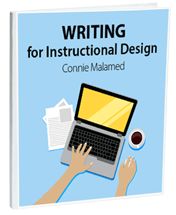As a learning experience designer, it pays to keep your eye on the big picture.
No one wants the headaches associated with going down the wrong path. Getting a birds-eye view of the situation can help. Here are five smart questions to ask when you first meet with a client.
 1. What is your organization’s goal?
1. What is your organization’s goal?
The work you perform for an internal or external client will have better results if you are aware of the client’s key goal and mission. At the highest level, you can ensure your work is aligned with their goals. At the most detailed level, you can choose words and images that are in sync with what they are trying to achieve.
If your client is a business, then the question becomes,”What is your company’s business goal?” Many of us, however, work with nonprofits, academic and governmental organizations. So even though their goals may not be primarily business-oriented, these organizations also have a primary mission. Training interventions must align with the organization’s goal to be meaningful.
2. Will the problem or issue be solved with training?
Many clients jump to the conclusion that training is the answer to their problems. Yes, this is a nice change from the days when people thought training was a waste of time. But the fact remains that training is not always the solution.
So when you hear what your client wants to achieve, think through whether training is the best solution. Consider if this is a skill that needs practice (learning activities will help) or if it’s a matter of distributing information (send an email or post on a website). You might want to run it through the Five Moments of Need test.
Some other possibilities include: performance support (job aids, mobile apps, wikis, help desk); encouraging mentor relationships; discussions via social media; or a software modification if the problem is technical.
3. What are the biggest obstacles to solving this problem?
As you discover the obstacles, you’ll be able to piece together the solution. First, attempt to categorize the form in which the obstacles exist.
For example, some obstacles, such as poor motivation and high turnover rates might stem from an organization’s negative culture. On the other hand, when employees can’t remember how to perform complex tasks or need to memorize long scripts, then most likely, job performance support is missing.
In Cathy Moore’s Action Mapping technique, she recommends asking, Why aren’t they doing it?
4. In what type of environment will learning occur?
When formal training is a potential solution, it’s important to understand the environment in which learners will be immersed. If call center employees need to quickly reference a procedure, they will be working in a noisy environment. In this case, they may need to search a well-written database of answers to common problems. A solution with audio wouldn’t work.
On the other hand, some interventions must develop long-term capabilities and require hands-on training. When healthcare workers need to learn how to manage patients with infectious diseases, the training and practice might take place directly in the hospital with an educator or leader.
5. How do employees feel about online learning?
Perhaps you’ve heard a little grumbling about eLearning lately? Many employees have been inundated with too many page turners and too little engagement. If you discover that audience members have been turned off to training—and online learning in general—this is your chance to turn the tide.
Use this as an opportunity to give learners streamlined training with more relevance, personalization, greater engagement and reduced information than they’ve ever had before. You might have to fight for it, but it’s worth the effort.
What questions work for you? Share in the Comments section below.






[…] 5 Smart Questions Instructional Designers Should Ask: The eLearning Coach: Instructional Design and … […]